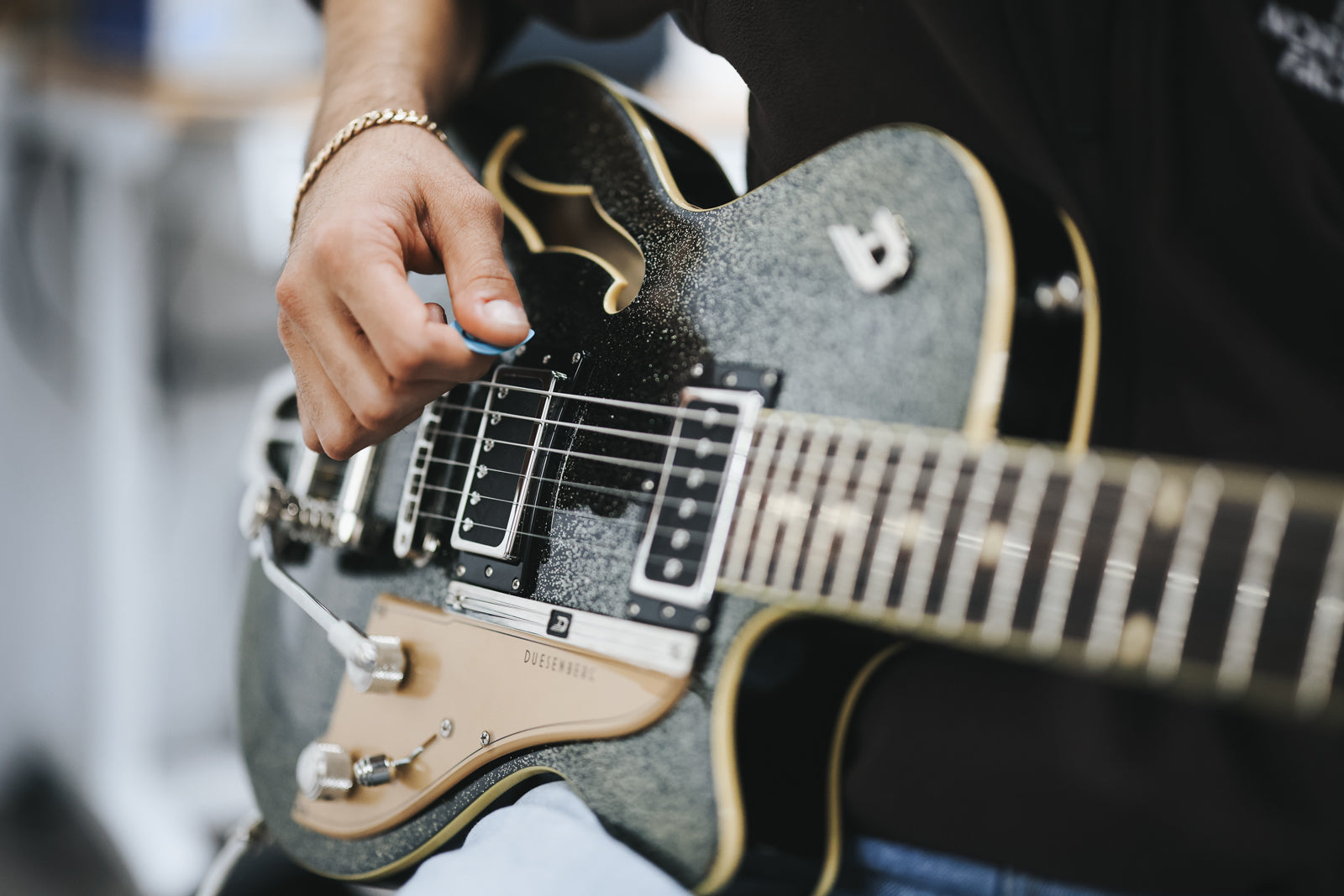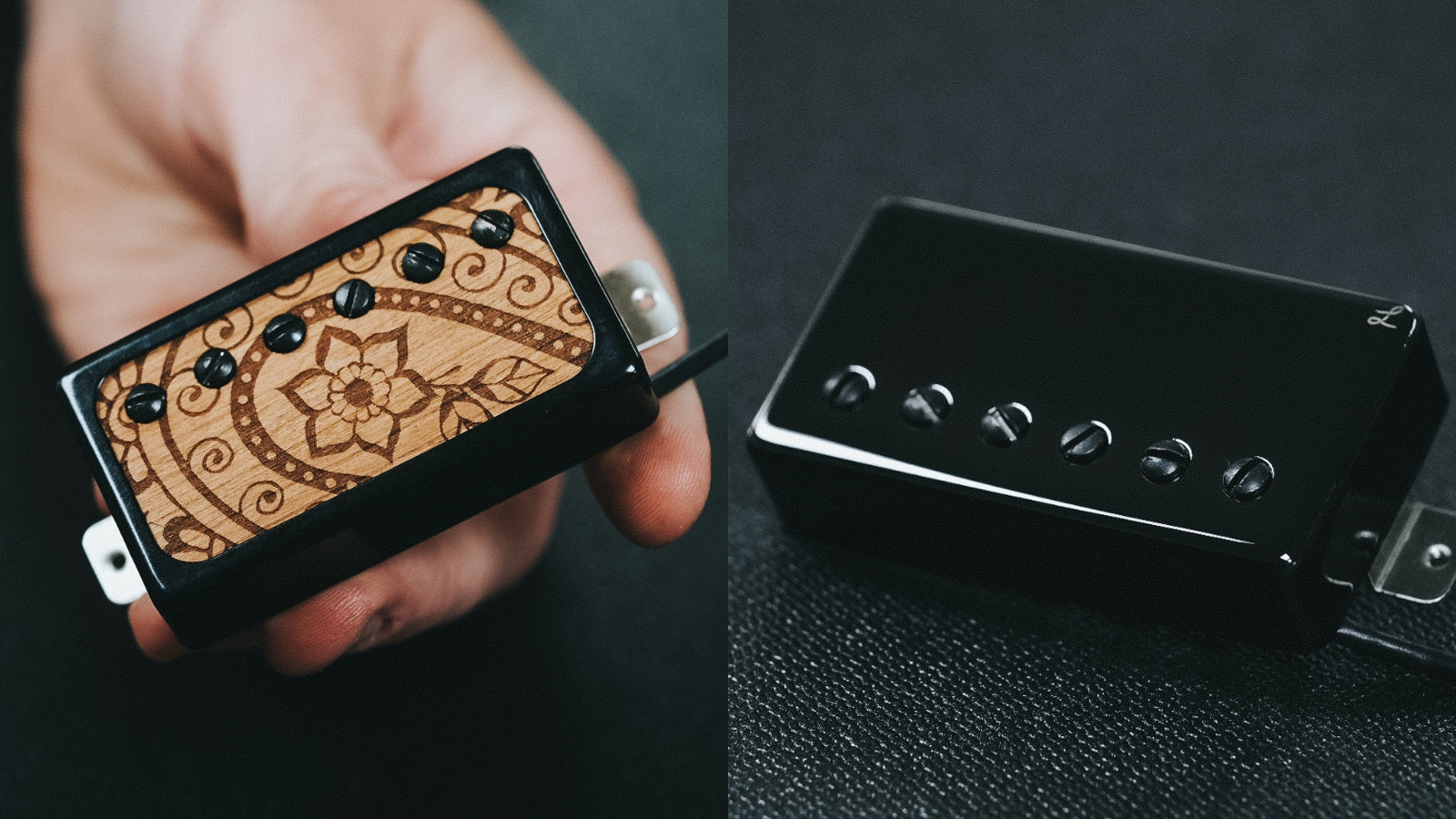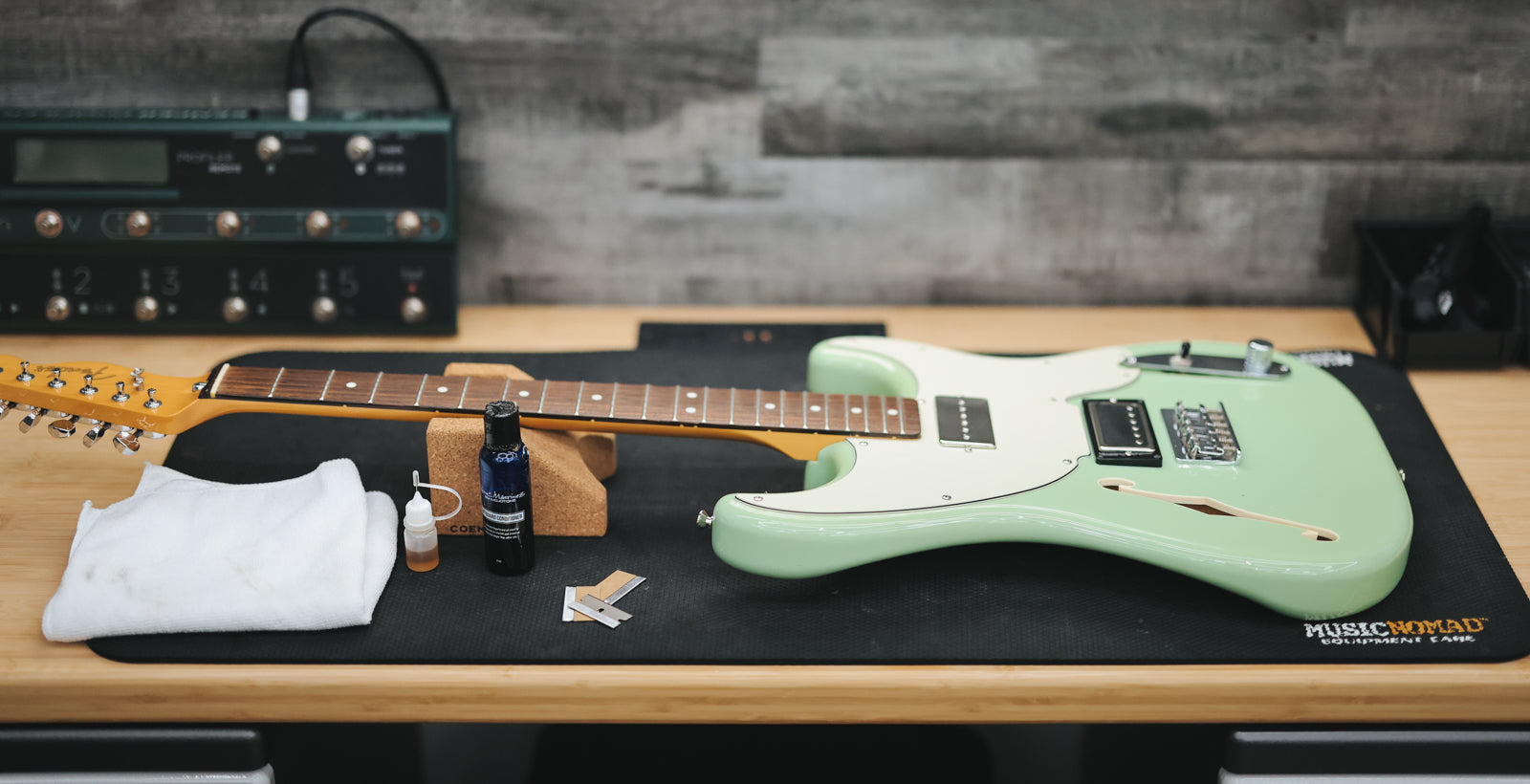
How Often Should You Change Guitar Strings
Guitar strings might seem like a small detail, but they have a meaningful impact on your tone and playing experience. As a lifelong guitar nerd (and pickup builder), I’ve learned that keeping your instrument in tiptop shape can be the deciding factor in whether your tone is inspired or not. Playing a crappy feeling guitar with rusty strings does not inspire confidence, am I right? One of the best ways to maintain any guitar, electric or acoustic, is to change the strings regularly. Fresh strings can bring the feeling of your instrument back to life, improve your tone, maintain stable tuning, and just feel better to play. In today’s post, I’ll share some thoughts on how often you should change guitar strings for the best performance, why it’s important, how to tell when it’s time, and tips to make your strings last longer (because who doesn’t want to save a few bucks?). Let’s dive in!

How Often Should You Change Guitar Strings
Everybody’s got an opinion on, “How often is often enough to swap your string?” Guess what? I have an opinion on this too! My honest answer is: it depends on a few factors. In this post, I’m going to talk about why you need to change guitar strings (spoiler: it can seriously improve your tone and reliability), then I’ll break down how often to change guitar strings for different situations (from occasional bedroom playing to studio trackers). I’ll also cover when to change guitar strings – the telltale signs that your strings are past their prime, and finally, how to make guitar strings last longer so you get the most bang for your buck. By the end, you’ll be equipped to keep your guitar sounding fresh and ready to play inspiring tones at any moment. Let’s get started!
Why Do You Need to Change Guitar Strings
Regularly changing your guitar strings is more than just a chore; it’s key to maintaining your instrument’s sound and playability. Here are some big reasons why you shouldn’t let your strings get too old and crusty:
Better Tone and Sound Quality
Over time, strings accumulate dirt, oils, and oxidation that dampen their vibration capacity. Vibrating strings are what interfere with the magnetic field of our pickups, which are critical to our guitar's tone, so this is really important! Old strings sound dull, flat, and lack the sparkly bright tone that new strings have. A fresh set of strings often will restore clarity, brightness, and sustain to your guitar’s sound. If you’ve been wondering why your guitar’s tone has lost its “zing,” worn-out strings are the first and easiest place to check. Changing them can instantly revive a lack-luster guitar tone and let your instrument sing again. In short, new strings = better tone!
Bonus Info: If you want to know more about how magnet fields work and why ferrous metals (your strings) directly impact your guitar tone, check out our blog post about the secret sauce behind clear and dynamic guitar tone here.
Improved Tuning Stability and Intonation
Are you constantly tuning your guitar, only for it to slip out of tune after one song? That was me too, and old strings might be to blame! As your strings wear, they don’t hold their tuning as well since they can develop subtle kinks or uneven stretching that make stable tuning a nightmare. Even more surprising, worn strings can throw off your intonation! This means that certain frets can start sounding slightly out of pitch, even when the open strings are tuned properly. By installing a new set, stretching them properly, your guitar will stay in tune much better, and notes up the neck will sound more in tune with each other. If you’re gigging or recording, fresh strings are essential for maintaining reliable tuning. It’s a small investment to avoid off note from an old string that just won’t behave.
Fewer String Breaks (Reliability)
Strings that have been on your guitar for ages are more prone to snapping at the worst possible time. Metal fatigue is real, and after enough note bending, fret pressing, sweaty/oily hand touching, an “old” string can become weak. The last thing you want is a string break in the middle of a song or set. Experienced players and guitar techs will tell you that fresh strings are far less likely to break unexpectedly. By changing your strings regularly, you ensure each performance or practice is worry-free on the string front.
Reliability matters, and new strings are much less likely to let you down. As a bonus, if you do ever break a string, having recently installed strings means you can replace just that string and it’ll still sound okay, whereas popping a brand-new string amidst a dead old set will stick out tonally. So, save yourself the headache and swap them out before they get crusty and brittle.
Better Feel and Playability
Maybe worse than sounding bad, prone to break, unstable tuning; is that old guitar strings feel rough and stiff. Over time they accumulate grime and the metal corrodes, which makes them drag under your fingers. Bending and sliding on rusty strings can even hurt (and leave your fingertips smelling like old pennies). New strings, on the other hand, feel smooth as butter. Your fingers glide easily, bends are more comfortable, and you’ll likely hear less finger squeak. Fresh strings also have a nice pliability to them (especially lighter gauges) whereas heavily worn strings can feel like high-tension wires. If you’ve been struggling with a guitar that’s hard to play, a new set of strings can surprisingly make it feel a bit “slinkier” and more enjoyable. Beyond feel, the coating (if any) on new strings is intact, whereas on old coated guitar strings the coating may have started to wear off, exposing the string to more grime.
Why is this worse than the former issues? Well, in my opinion, a good feeling guitar is more inspiring to pickup and play than a great sounding one. And a guitar that is inspiring to play more means you’ll practice more, improve quicker, and overall become a better guitar player and make lasting impact with your audience and community. That’s why we do what we do here at Lambertones. Loving your tone is simply the vehicle to becoming a better and more impactful musician.
Knowing your guitar is well-maintained gives you confidence. I’ve seen guitars come into the shop with strings that have been dark brown, have black spots, and even green from corrosion… trust me, that’s not a good look (literally or sonically). Putting on a fresh set not only makes the guitar sound and feel better, it also can be inspiring and make you want to play more. It’s like giving your guitar a little spa day, and it rewards you with great tone. So, changing strings is part of loving your instrument.

How Often to Change Guitar Strings
Electric guitar strings are usually nickel-plated steel, which tends to have a different lifespan and feel compared to acoustic strings. In practice, the timeframe is pretty similar, but most electric guitar players also adhere to the ~3 month (90 days) interval for a regularly played instrument. If you play your electric daily or have sweaty hands, you might find they need changing closer to 4-6 weeks to maintain that new-string brightness.
On the flip side, if you only pick up your electric occasionally at home, you could go longer; just be aware that even unplayed strings can slowly tarnish. I’d say even on a seldom-used electric, swap in a new set at least twice a year so you don’t deal with rust or dead string issues..
The context in which you play matters here. If you’re a performing electric guitarist – say, playing gigs on the regular, you’ll likely change strings much more often. Some gigging electric guitarists change strings every couple of weeks, or before major shows or tours, just to be safe. If you’re recording in the studio, throwing on a fresh set beforehand is pretty common.
One advantage with electric guitars is that amplification and effects can sometimes mask dead strings a little more than an acoustic can. Overdriven amps, distortion, etc., naturally add harmonics, so an old string on an electric might not sound quite as obviously dull as it would on an acoustic. Don’t let that “benefit” be a crutch in your tone though, cause if your distorted riffs start losing their bite or your guitar won’t stay in tune during a big bend, it’s time for new strings. In summary, treat your electric guitar to fresh strings every few months if you’re a casual player, and more frequently (weeks, or before important events) if you play a lot, perform often, or just crave that new-string feel and sound.
(Note: These are guidelines, not hard rules. Every guitarist finds their own rhythm for string changes. Some change strings like clockwork, others go by feel. Next, we’ll look at concrete signs that will tell you it’s time for a swap.)
When to Change Guitar Strings
How can you tell your strings have truly reached the end of the line? Here are some clear signs it’s time to change your guitar strings. If you spot any of these, do your axe a favor and put on a new set:
Broken or unwinding string:
If one of your strings breaks, it’s definitely time for a change!
Rust, discoloration, or dirt buildup:
Take a look at your strings under good light – do they still shine like metal, or have they turned dull gray/brown? Over time, the oils from your fingers plus exposure to air will tarnish most strings. You might also notice certain areas (like between the frets you use most) are darker or splotchy. If your strings have visibly changed color, have rust spots, or you can scrape gunk off them, it’s a big red flag.
Won’t stay in tune or intonate properly:
Tuning issues are notorious with old/dead strings. After the initial stretching period when you first put strings on (when new strings constantly slip into flat until stretched), strings should hold tuning stable for a while. If you find that even after tuning up, a few chords make certain strings go noticeably flat or sharp, and this keeps happening, your strings might be past their prime and need to be swapped.
Dull, dead tone:
Your ears are great at telling you when strings are done. Remember how bright and lively your guitar sounded with brand-new strings? Compare that to now. Old strings lose the high-frequency zing and can start to produce a “thuddy” or flat tone with less sustain. If you strum a chord and it just doesn’t ring out or feels like it’s missing harmonics, that’s a classic sign of dead strings.
Strings feel rough or stiff:
Your sense of touch can also tell when strings have expired. Gently run your fingertips along the underside of the string. Does it feel smooth or can you feel rough patches? Old strings often accumulate grime or the metal itself pits and corrodes, resulting in a coarse feel. They might even squeak more when you slide because of the extra friction. So if your strings feel rough to the touch, or you see dark tarnish coming off on your fingers after playing, it’s a sure sign they need changing. Your fingers (and audience) will thank you.

How to Make Guitar Strings Last Longer
Let’s say you’ve put on a new set of strings, sounds great, feels great. How do you keep them that way as long as possible? While you can’t make guitar strings last forever, here are several tips to extend the life of your strings and get maximum value from each set:
Wipe down your strings after every play
This is the number one habit to adopt. When you finish playing, take a clean microfiber cloth and wipe the strings along their length. Do it both on top and underneath the strings if possible. This simple motion removes the sweat, oils, and gunk your hands deposited on the strings. By cleaning them off, you slow down the corrosion process. It only takes 10 seconds, but it can add days of good tone to your strings' natural life.
Use a string cleaner or conditioner
Beyond just dry wiping, there are products made to clean and condition guitar strings. These usually come in a little bottle or pre-soaked wipes. After playing, you can apply a string cleaner that will help dissolve sweat and prevent oxidation. They often leave a thin residue that inhibits rust and can make the strings feel slicker. Using a string cleaner once every few plays can significantly extend string life, especially if you tend to have sweaty or acidic hands.
Wash your hands before playing
I know, sometimes you just want to pick up the guitar and jam, but if you can, wash your hands first. It’s amazing how much longer strings last if you start with clean hands. Washing removes a lot of natural oils, sweat, and dirt from your fingers so that all that gunk doesn’t transfer to the strings immediately.
Store your guitar in a case or low-humidity environment
Hanging your guitar on the wall or leaving it on a stand is fine for short-term convenience, but if you want strings to last, consider storing the guitar in its case when you’re not playing for extended periods. A case provides a more controlled environment, shielding the guitar from dust and slowing down temperature/humidity swings that can accelerate string corrosion. If you live in a humid area, toss a few silica gel packets in the guitar case to absorb moisture, your strings (and guitar wood) will benefit. Conversely, very dry environments aren’t as big a culprit for string wear, but dust is. In a case, your strings won’t be collecting dust that can hold moisture and promote rust. It sounds a bit paranoid, but these small things can add up to significantly longer string life, meaning more money stays in your pocket for other gear and tone upgrades.
Keep the guitar well set up (and clean the fretboard)
A properly maintained guitar not only plays better, it can help your strings last. How so? If your guitar’s frets are clean and smooth and the nut slots are lubed and shaped right, your strings will experience less friction and abrasion. Rough fret edges or a burr on the bridge saddle can literally saw into your strings and cause premature breakage or wear. So as part of string maintenance, do a quick check: are any frets rough or dirty? Is the fretboard caked with fingerboard gunk? When you change strings, take a minute to clean the frets and fretboard thoroughly (lemon oil for the fretboard, polish the frets if needed). If you leave grime on the fretboard, it can transfer right back onto your new strings, undoing the benefit of a change. Also, consider a tiny deposit of graphite (shaving the “lead” of a wooden pencil is my “poor man’s method” and if works great!) or nut lubricant in the nut slots when restringing. It will help the strings move freely (especially for tremolo use or big bends) and prevents metal-on-nut binding which can wear them out. In short, a well-maintained guitar = a happier environment for your strings.
Try coated strings for extended life
This is a touchy topic, because a lot of electric guitar purists will denounce coated strings…. BUT IF you really want strings that hold up longer, give coated guitar strings a shot. Major string brands offer coated versions (Stringjoy, Elixir, D’Addario XS, Ernie Ball, etc.), which have an ultra-thin polymer layer that protects the metal from corrosion. These can dramatically extend how long strings sound “fresh.” In fact, most coated or treated strings can last two to five times longer than traditional uncoated strings before sounding dead. Now, coated strings do come with some trade-offs: they cost more, and some players feel they slightly dull the initial brightness or feel a bit slippery. But technology has improved a lot, and many coated strings nowadays sound very close to regular strings. If you’re the kind of player who hates changing strings or you sweat a lot, coated strings might be your best friend. They can be budget friendly in the long run since you buy one set instead of three in the same time span. Just remember, even coated strings won’t last forever – the coating itself can wear thin (or flake off in spots) eventually with heavy use. But they will absolutely buy you more time between changes.

In the end, every guitarist finds a balance they’re comfortable with. There’s no strict rule for how often you must change your guitar strings, it’s about what keeps you and your instrument happy.
One final tip: always keep a spare fresh set of strings in your case or gig kit. Murphy’s Law says strings tend to snap at the worst times, like right before a show or in the middle of a session. Having a backup set handy means a broken string doesn’t ruin your day forcing an unintended trip to your closest Guitar Center.
To wrap up, remember that changing strings regularly is one of the easiest and most cost-effective ways to keep your guitar sounding great. Your tone, tuning stability, and fingers will all benefit. So don’t neglect those strings until they turn to rusty railroad tracks, show your guitar some love with a set of new strings when needed. Trust me, when you hear and feel the difference, you’ll be glad you did.
And if you’re curious about other ways to improve your guitar tone (besides fresh strings), be sure to check out our post on how to get a good tone on guitar for more tips and tricks.



Leave a comment
This site is protected by hCaptcha and the hCaptcha Privacy Policy and Terms of Service apply.